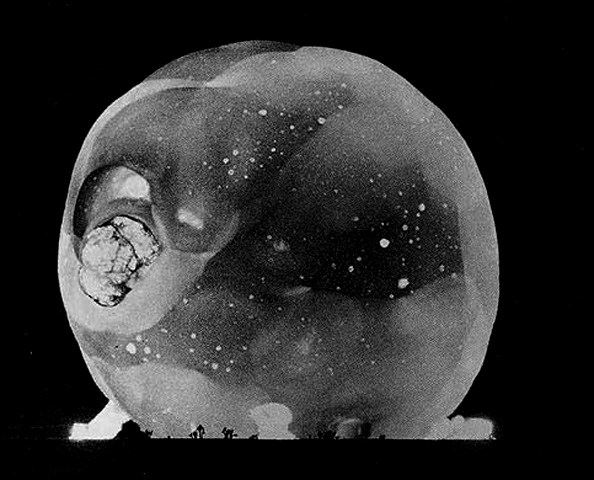
“All things move, all things run, all things are rapidly changing. A profile is never motionless before our eyes, but it constantly appears and disappears. On account of the persistency of an image upon the retina, moving objects constantly multiply themselves; their form changes like rapid vibrations, in their mad career. Thus a running horse has not four legs, but twenty, and their movements are triangular.”
— Umberto Boccioni, ‘Futurist Painting: Technical Manifesto’ (1910)
Discovering the work of Idris Khan (see previous post) – in particular After Eadweard Muybridge ‘Human and Animal Locomotion’ (2005), a combination of Muybridge’s motion studies in a single image (see below) – has triggered me to do some explorations on the condensation and synchronisation of time in photography and cinematography. Khan refers to his own condensed photographs as “a playful emblem of our own departure from the corpse of photography, burdened with what the Futurist Anton Guilio Bragaglia once referred to as its ‘glacial reproduction of reality’.” Bragaglia (1890-1960) is a good starting point to explore this fascinating zone between art and science. Influenced by Henri Bergson’s ideas about the infinite continuity of time, This Italian Futurist created the term “Fotodinamismo” to define the photographs he made with his brother Arturo. Their aim was to look for an alternative means of capturing the essence and sensation of speed and motion than the sequential analysis, driven by Muybridge‘s work (studying motion using several still cameras and taking photos from many angles at the same instant in time) as well as Etienne-Jules Marey‘s so-called”chronophotography” method (using a slow motion camera with the capacity of taking 700 images per second) – which was to lead ultimately to the perfection of the illusion of movement with cinematography.
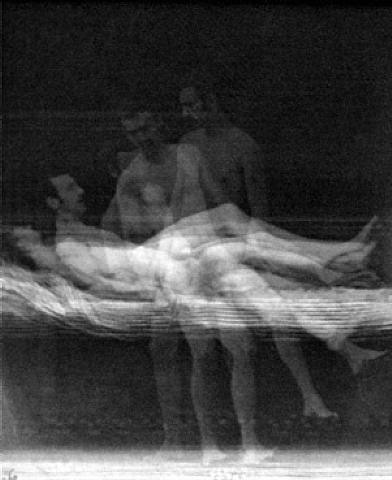
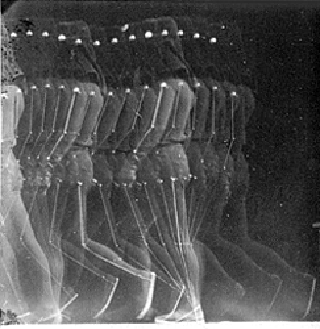
Essentially the Bragaglias wanted to “depict movement as an indivisible reality, rather than a sequence of static poses.” “We are not interested in the precise reconstruction of movement, which has already been broken up and analysed. We are involved only in the area of movement which produces sensation, the memory of which still palpitates in our awareness”, Bragaglia wrote in his Futurist Photodynamism (1913). Fotodinamismo would render actions visible “more effectively than is now today possible with actions traced from one point, but at the same time keeping them related to the time in which they were made…”. Bragaglia advanced the theory that speed applied to actions or objects renders them immaterial and invisible: “appearance is replaced by transparency”. Bragaglia’s photodynamics are fluid “visual transcriptions of energy” —not by way of successive pictures (Muybndge) or schematic phases (Marey)- but as a smooth, continuous dematerialization of objects in space. This was accomplished by means of capturing in a single image the flowing trajectories of objects in motion, made visible by long exposure times. Well known studies, pictured here, include ‘Typewriter’ (1911), The Slap’ (1912) and ‘The Cellist’ (1913).



A similar result is visible in the work of Frank (1868–1924) and Lilian Gilbreth (1878–1972), although their method and motivation were quite different. They developed the “stereo chronocyclegraph”, 3-D photography that traced the path of human motion in pulses of electric light, in order to identify the “one best way to do work.” The Gilbreths wanted to convert their images (“micromotion studies”) into useful data for employers eager to reorganize and increase production. Small electric lights, blinking twenty times a second were attached to the wrists of the workers and one cycle of their motions was photographed in a darkened studio (the “betterment room” the called it). Since the lights traced pearl-shaped exposures on the photo- graphic plate, one could identify the direction of the hand movement. Grids placed in the background, or double-exposed later, measured distance while clocks recorded elapsed time. The distance between the light tracings revealed changes in speed. Of course this methodology of “scientific management” – that led to the standardization of work practices and the development of ‘Continuous Improvement Process’ (CIP) – has been criticised widely: the resulting images, after all, could be seen as portraits of the dehumanizing tendencies of modern industrial labor. One criticist is Mike Mandel who decided to subvert the reasoning behind these efficiency studies. In his book ‘Making good time: scientific management, the Gilbreths, photography and motion-futurism’ (1989), he writes: “In my own pictures I want to turn the Gilbreths upside down and shake them out of my brain. I want to find the “one best way” for the worst of reasons—to analyze motions that have never been measured and don’t need to be. I want to completely reevaluate day- to-day life, distorting the Gilbreth imperative to suit my needs: More waste = more fun”.
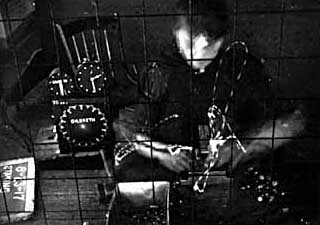

Bragaglia and the Gilbreths of course worked in a time when the representation of motion became a compelling concern for scientists, photographers and artists alike. According to Siegfried Giedion (in ‘Mechanization Takes Command’, 1948) the depiction of motion was the key imagery of the twentieth century: ” the essence of the phenomenal world has been increasingly regarded as motion-process: sound, light, heat, hydrodynamics; until, in this century, matter, too, dissolves into motion.” Another figure who took this concern at heart was Harold Eugene Edgerton (1903 – 1990), an electrical engineer at the Massachusetts Institute of Technology (MIT), who perfected the stroboscope for use in both ultra-high-speed and still (or stop-motion) photography. This device – first developed by Joseph Plateau – allowed him to take images of a realm beyond human vision. Starting from the 1920’s he manipulated the stroboscope to create two types of images. In one technique, a single, brief exposure documents a specific event in time, and magically captures its effects. In the wellknown photograph ‘Shooting the Apple’ (1964) for example, Edgerton seized the moment just as an apple is pierced by a passing bullet, leaving a cloud of skin and flesh in mid-air. Though only moments later the apple would explode, Edgerton has frozen time to order to illustrate the laws of physics. This effect was also accomplished with the “rapatronic camera” he developed in the 1940s, which was used to photograph the rapidly-changing matter in nuclear explosions within milliseconds of ignition – resulting in utterly frightening or beautiful pictures, depending on the way you want to look at it (see top). Edgerton also used the stroboscope to record the cumulative forms described by bodies moving through time, especially of athletes in action.. In ‘Densmore Shute Bends the Shaft’ (1938), a golfer swings his driver which creates an apparition of a nautilus shell – a perfect form in nature equal to the perfect form and grace of his swing. “Seeing the unseen” – the title of a book on his achievements – is really what is was all about for him: later in his carreer he also created night-vision imaging systems with the Defense Department during World War II, enhanced underwater imaging of the ocean floor in consultation with the National Geographic Society and Jacques Cousteau – accompanying him on numerous expeditions – and even worked with some Hollywood Studios, demonstrating how to use high-speed photography to make movies. He even won an Academy Award for the short film ‘Quicker than a Wink’ (1940), produced in association with Pete Smith (anyone know where to find this?). “Don’t make me out to be an artist”, he said. “I am after the facts, only the facts. In many ways, unexpected results are what have most inspired my photography.” If only he could have witnessed the impact that the “Bullet-time” effect had on millions of movie buffs worldwide, when the ‘The Matrix’ finally hit the cinemas, 9 years after his death (note that ‘The Matrix’ wasn’t the first film to use this effect – Michel Gondry, Dario Argento, Tim Macmillan and others used it years before it came out).
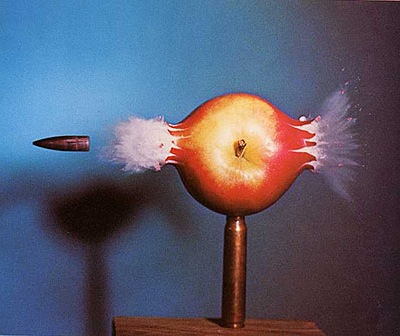
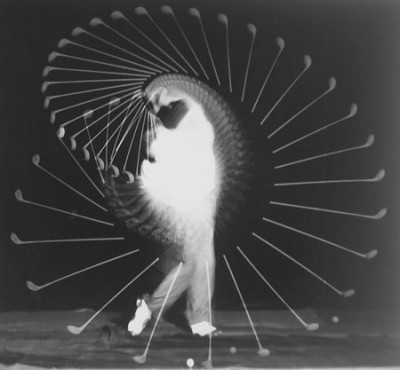
It’s one of Edgerton’s colleagues at MIT, Gjon Mili (1904-1984), who introduced the stroboscope techniques in the artworld. Mili, who was a photographer for Life Magazine for over 4 decades, took thousands of pictures of dance, athletics, and musical and theatrical performances. He also used some of the methodes in the short film ‘Jammin’ the blues’ (1944), featuring performances by musicians such as Lester Young, Red Callendar, Harry Edison and “Big” Sid Catlett, which is considered as a minor landmark in the way musicians are filmed. He took some impressive pictures of musicians in action – notably of drummer Gene Krupa. In 1950 he also made a new version of Marcel Duchamp’s ‘Nu descendant un escalier n° 2‘ (1912), which was in itself influenced by the work of Marey and Futurists such as Bragaglias and Giacomo Balla. But his most famous photographs must be the one the took of Pablo Picasso, in 1949. Picasso was photographed in the dark. After Mili fired his flash, Picasso sketched a centaur in the air. The result is pictured below. This form of painting with light was later developed futher by people like Eric Staller. In the late the 1970’s Staller made quite a name for himself with his series of long-exposure images shot in the streets of New York City. He set the camera up on a tripod whilst he manipulated light in the frame to make an array of patterns and colours.
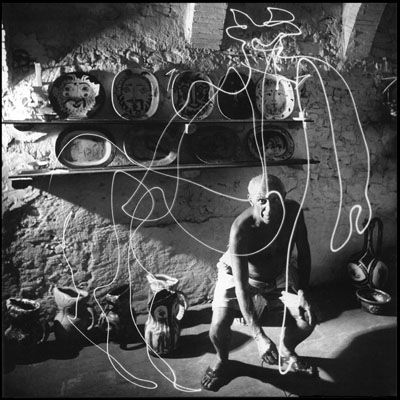
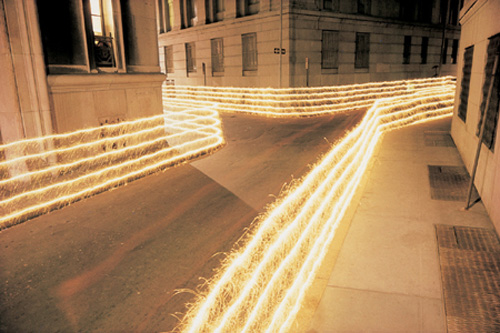
In these examples one can basically point out two ways to visualize structures of time and its relationship to space, using various techniques of photography and cinematography. While Edgerton and others tried to “freeze” movements in images, the “photo dynamists” were more interested in the transgression of synchronized time relations. The resulting effects were dependent on parameters such as the length of exposure, the timing of natural or artificial light and the development time required to expose the film. Some contemporary artists use digital technologies to extend these studies in new domains. One could say that the means of conventional photography serve more or less the fusion and condensation of temporal processes, while digital technology allows a layering and superimposition of individual temporal segments. Heike Helfert gives some nice examples in her essay ‘Technological Constructions of Space-Time. Aspects of Perception‘.”In his photograph series ‘Theaters,’ which he has been working on since the 1970s, Hiroshi Sugimoto exposes the cinema as a site that shapes space and time with light. Usually, the architectural space of the cinema steps into the background as soon as the light of the projector is turned on. Sugimoto, however, condenses the entire film on one photo, inverting the relationship of real space to illusionary space. He exposes his photographs over the entire course of a film showing, and thus returns film to its foundation, that is, light. The entire film is thus contained in a single photo, but due to the long exposure time the screen only appears as a bright surface. All that remains visible is the physical space of the cinema.” Thomas Kellein, in his essay in the book ‘Hiroshi Sugimoto, Time Exposed’ writes:”The white rectangle in the Theaters obliterates the stream of images and captures in a blaze of light the whole time factor of moviegoing. Only thus, as the trace of an illumination, does the cinematic experience have duration for Sugimoto. Light assumes the place of a story, whatever its title, and of the arbitrary, constantly shifting positions of the camera. Not only are individual films transitory; the film medium itself, photography’s great rival, seems to have lost its capacity to survive.”
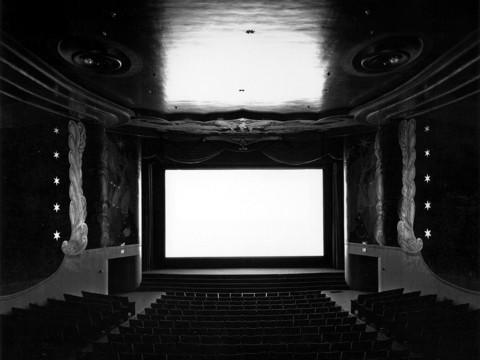
A similar goal is pursued by Jim Campbell (a brilliant artist with degrees from MIT, who also holds dozens of patents in the field of video image processing) in his’ Illuminated Averages’ project, a series of images displayed in light boxes in which each image is created by “averaging” all of the frames of a moving sequence. For example the first one created (2000) was an average of all the frames of the film ‘Psycho’. Placing all of the frames on top of each other, he created an image that contains all of the film’s visual data (I would love to see ‘Accumulating Psycho’ (2004), the video that documents this gradual accumulation process, with the sound of the film remaining intact!). “But he works with digital, and not analog, technology”, writes Helfert. “At issue is thus not the duration of exposure that produces a certain amount of light, but the addition of individual film images and their data. Here, image after image are superimposed on one other, producing a concentration of light and contrast that only allow the outlines of a plot to be glimpsed in the less strongly illuminated parts of the image. In this process, time manifests itself as light and the superimposition of different degrees of brightness.” The influence of Bragaglia and Balla in particular is apparent in other works in this series, for which he videotaped movement of several objects – a clock, an automobile, a bicyclist, a cow – for a specific period of time, and then used custom hardware to average the multiple frames into one single image. The result is a blurring effect that gives the appearance of motion.
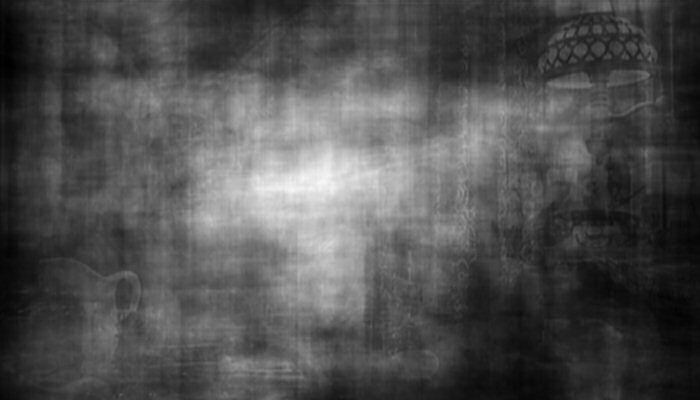

There are quite a few contemporary artists/scientists exploring similar ideas. Jason Salavon has used custom made software to “average” sets of photographs (but also music & video) sharing common characteristics, like Playboy centerfold foldouts (in ‘Every Playboy Centerfold, The Decades’, 2002) and late night talk shows (the video installation ‘The Late Night Triad’, 2003). Besides these “amalgamations” he’s also done works with “color-averaged frames”, in which the overall color-value of individual frames of film and video are used to compose abstracted projects. ‘The Top Grossing Film of All Time, 1 x 1’ (2002), for example, is a static image showing all of the frames of the movie ‘Titanic’ reduced to the average color most representative of each frame. In the same vein Antonio Torralba and Aude Oliva ( both @ MIT) made a series in which images containing a person are averaged to reveal regularities in the intensity patterns across all the images. In the series ‘Go Ogle’, Meggan Gould has taken the first 100 responses to a Google image search – like “heart” – and overlayed those images into a single photographic “average.” As Gould herself writes: “The results, a visualization of intersections between Boolean logic and the popular imagination, are more often than not a hopeless jumble of unidentifiable pixels – but occasionally a recognizable form does emerge.” Atta Kim (who holds a degree in mechanical engineering) has done similar stuff in his ‘ON-AIR ‘ series, which consisted of “overlaid” images, as well as extended exposures that record the dissipation of objects and people. Influenced by Heidegger’s speculations on time, along with the teachings of the mystic G. I. Gurdjieff and Zen Buddhist thinking, he bases his work on notions of interconnectedness and transience – time as a quantifiable, linear entity is a mirage. His view of several NY locations leaves all the stationary elements in focus, but reduces traffic to a shimmering haze, a ghost of motion. A couple making love for an hour is a cloud of luminosity.

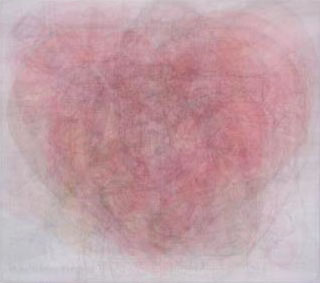
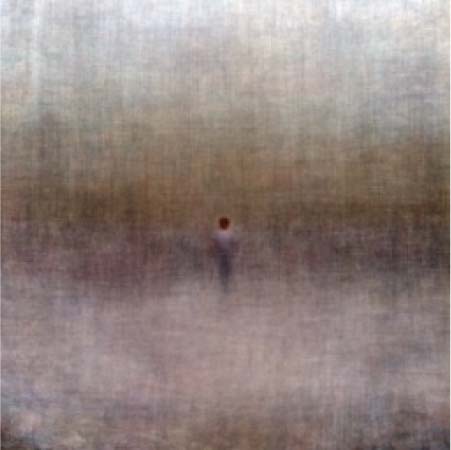

Idris Kahn, who I mentioned before, has done some fascinating work. Noteworthy is the series of images he made by superimposing Bernd and Hilla Becher‘s photographs of industrial buildings, while digitally manipulating them to emphasise certain details or to enhance areas of light and shade. He has said: “it’s obviously not about re-photographing the photographs to make exact copies, but to intervene and bring a spectrum of feelings – warmth, humour, anxiety – to what might otherwise be considered cool aloof image. You can see the illusion of my hand in the layering. It looks like a drawing. It’s not systematic or uniform. The opacity of every layer is a different fallible, human decision”. The resulting, strangely transient, images do have quite a bit in common with some of Krzysztof Pruszkowski’s ‘Photosynthesis‘ work, which he started in 1975 – and without the use of digital techniques. Jerome Sans has written: “By subjecting his photographic topics, whether they are taken from the media or not, to “multiple superimpositions,” Krzysztof Pruszkowski demonstrates the limits of the new reality–a reality which dissolves the notion of time picture by picture and, in a way, accounts for the speed which characterizes some video clips, the instant circulation of information and pictures around the world. We are no more in the order of the snapshot. (…) The artist does not interpret the world by establishing its apparent form but rather restores its complexity and places it in a context which reveals the richness of its metamorphosis”


Others took the condensation of motion in surprising directions. Fiona Banner for one explores the relations between linguistic and visual perception in her “still films”: handwritten, blow-by-blow descriptions of films such as ‘Apocalypse Now’ (along with other war movies in ‘The Nam’, a 1,000-page book, 1997), ‘Lawrence of Arabia’ (‘Desert’, using a vast plane of text similar in scale to a cinema screen – or an expanse of desert, 1994) and ‘Don’t Look Back’ (an installation with the same title screened across three wallpaper panels, 1999). The entire movies can be seen – but not read, because the words pile on so thick that they become too dense to read – in an instant, on a single canvas. For her this transformation is a “stepping back from how the image works on us, yet at the same time still having the image there. It’s a way of being able to work with images without drowning in the deeply complex currency of those images. Hopefully, what’s gained in the process is an original moment of looking at something, or being able to look at something in a different way by side-stepping the image.” In his ‘Cinema Redux’ project, started in 2004, Brendan Dawes explores the idea of distilling a whole film down to one single image by creating unique fingerprints. Films like ‘Taxi Driver’ (see below), ‘Serpico’ and ‘The Conversation’ are processed through a piece of software that samples a movie every second and generates an 8 x 6 pixel image of the frame at that moment in time. It does this for the entire film, with each row representing one minute of film time. The result is, according to Dawes, “a sort of movie DNA showing the colour hues as well as the rhythm of the editing process”. And then there’s also a series of intruiging long exposure photographs by Rosemarie Fiore, taken while playing old video war games. “By recording each second of an entire game on one frame of film”, she has written, “I captured complex patterns not normally seen by the eye”. Seeing the unseen, I guess, is what drives many of these artist/scientists. Their representations of motion make it clear that “the precise, mechanical, glacial reproduction of reality” is not the only way to perceive the passage of time.
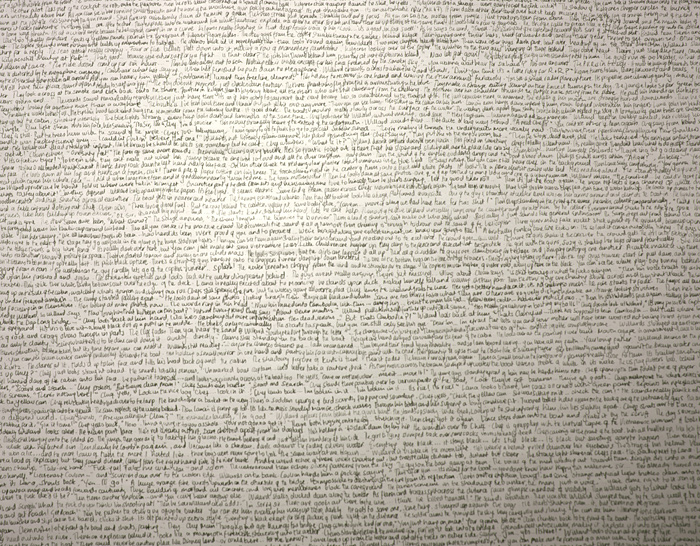


More later. Perhaps.